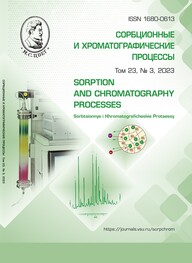Sorption processes in the "6-methyluracil-super-cross-linked polymer" system
Abstract
The study presents the results of investigation of the processes of sorption of 6-methyluracil (MU) by low basic anion exchanger A-100 and high basic anion exchanger A-500R, which have a macroporous structure. It was found that the maximum sorption was observed at pH 3.2-3.5; in the area when 6-methyluracil (6-methyl-2.4-dioxo-pyrimidine) was in the lactam form in the solution. The obtained sorption isotherms were analysed. It was noted that the formation of monomolecular layers of 6-methyluracil (MU) on A-100 and A-500R ion exchangers can be described by the Langmuir isotherm equation. With an increase in the MU concentration in the external solution, the sorption process was due to such interactions as the “sorbate-sorbate” association. Based on the literature data and IR spectroscopy data, it was shown that in macropores and on the surface of anion exchangers, polymolecular layers of methyluracil were formed. These layers were described by the Brunauer-Emmett-Teller (BET) equation. It has been suggested that in this case the formation of supramolecular structures in the form of ions and molecules of 6-methyluracil occurred. Hydrogen bonds and van der Waals interactions made the greatest contribution to the absorption of MC by sorbents. Along with this, the manifestation of electrostatic forces is possible in the interaction between the sorbed ions of 6-methyluracil.
Possible prospects for the use of hypercrosslinked anion exchangers for the isolation and concentration of 6-methyluracil from food production solutions were considered. For this, the sorption of MU under kinetic conditions was studied taking into consideration the acidity of the solution. Based on the kinetic data obtained during the experiment, it was suggested that the sorption process is limited mainly by the internal diffusion stage. The diffusion coefficient of MU on A-100 was 1.12·10-9 cm2/s; for A-500R it was 2.45·10-9 cm2/s. The time to reach equilibrium on the considered sorbents was on average 60 minutes.
Downloads
References
Ivanov V.A., Gorshkov V.I., 70 let istorii proizvodstva ionoobmennyh smol, Sorbtsionnye i Khromatograficheskie Protsessy, 2006; 6 (1): 5-31. (In Russ.)
Bersneva V.S., Bakulev V.A., Sorbcionnye metody vydelenija produktov biosinteza. Ekaterinburg, Ural University Publishing House, 2018, 80 р. (In Russ.)
Bondarev A.V., Zhiljakova E.T., Ispol'zovanie sorbcionnyh processov v tehnologii system dostavki lekarstvennyh veshhestv, Pharmacy and Pharmacology, 2019; 7(1): 4-12. (In Russ.)
Studencov E.P., Ramsh S.M., Kazurova N.G., Neporozhneva O.V., Gara-badzhiu A.V., Kochina T.A., Voronkov M.G., Kuznecov V.A., Krivorotov D.V., Adaptogeny i rodstvennye gruppy lekarstvennyh preparatov – 50 let poiskov, Reviews of Сlinical Pharmacology and Drug Therapy, 2013; 11(4): 3-43. (In Russ.)
Krivonogov V.P., Chernyshenko Ju.N., Kozlova G.G., Jakovleva A.I., Spiri-hin L.V., Abdrahmanov I.B., Plechev V.V., Sivkova G.A., Battalov Je. M., Sintez 2,4-diokso-1,2,3,4-tetragidro-5-pirimidinil-2-metilakrilatov, Journal of Organic Chemistry, 2005; 41(1): 141-143. (In Russ.)
Belousova T.A., Farmakologicheskie svojstva metiluracila (obzorliteratury), Almanac of Retinoids, 2009; 28: 11-43. (In Russ.)
Plecheva D.V., Alekhin E.K., Ox-ymethyluracil stimulates reparative regeneration of skin in rats, Experimental clini-cal pharmacology, 2004; 67(5): 63-66. (In Russ.)
Terent'ev A.O., Borisova N.S., Hami-tov Je.M., Zimin Ju.S., Mustafin A.G., Jeksperimental'noe i kvantovo-himicheskoe issledovanija vzaimodejstvij 6-metiluracila s jantarnoj I fumarovoj kislotami, Journal of Physical Chemistry, 2014; 88 (12): 1908-1913. https://doi.org/10.7868/s004445371412036x (In Russ.)
Repina Je.F., Myshkin V.A., Karimov D.O., Timasheva G.V., Husnutdinova N. Ju., Smoljankin D.A., Bajgil'din S.S., Baki-rov A.B., Gimadieva A.R., Antigipoksicheskaja aktivnost' kompleksnogo soedinenija oksimetiluracila s askorbinovoj kislotoj, Toxicological Bulletin, 2018; 151 (4): 20-23. (In Russ.)
Davankov V.A., Tsyurupa M.P. Hypercrosslinked polymeric networks and adsorbing materials, synthesis, structure, properties and application. New York, Elsevier, 2011, 648 p. https://doi.org/10.1016/s0166-526x(11)56007-6
Tsuyrupa M.P., Davankov V.A., Hypercrosslinked polymers: basic principle of preparing the new class of polymeric materials, Reactive and Functional Polymers, 2002; 53(2-3): 193-203. https://doi.org/10.1016/s1381-5148(02)00173-6
Selemenev V.F., Slavinskaja G.V., Hohlov V.Ju., Ivanov V.A., Gorshkov V.I., Timofeevskaja V.D. Praktikum po ion-nomu obmenu. Voronezh, Voronezh University Publishing House, 2004, 160 p. (In Russ.)
Pisarev O.A., Samsonov G.V., Bogdanova L.P., Murav'eva T.D., Ionnogidrofobnoe vzaimodejstvie jeremomicina s setchatymi strukturnosegregirovannymi biosorbentami, Journal of Applied Chemistry, 1993; 66 (11): 2825-2828.
Kokotov Ju.A., Pasechnik V.A. Ravnovesie i kinetika ionnogo obmena. Leningrad, Chemistry Publ., 1970, 336 p. (In Russ.)
Dzhilkrist T. Himija geterociklich-eskih soedinenij. Moscow, Mir Publ., 1996, 464 p.
Oros G.Ju., Selemenev V.F., Hohlov V.Ju., Kal'chenko O.V., Kvazisinergicheskie javlenija v sisteme nukleinovoe osnovanie – makroporistyj anionit, Journal of Physical Chemistry, 1998; 72 (11): 2041-2045. (In Russ.)
Gus'kov V.Ju., Kudasheva F.H., Ivanov S.P., Struktura I poljarnost' modificirovannyh proizvodnymi uracila poristyh polimerov, Sorbtsionnye i Khromatograficheskie Protsessy, 2012; 12 (6): 916-921. (In Russ.)
Ivanov S.P., Lysenko K.A., Koljadina O.A., Starikova Z.A., Murinov Ju.I., Struktura i sorbcionnye svojstva 5-gidroksi-6-metiluracila, Journal of Physical Chemistry, 2005; 79(2): 278-284. (In Russ.)
Leonidov N.B., Uspenskaja S.I., Tolmachev A.M., Zhuravlev V.I., Korableva E.Ju., Usacheva T.M., Stroenie i bi-onejekvivalentnost' polimorfnyh form metiluracila, Journal of Physical Chemistry, 1993; 67(12): 2464-2468. (In Russ.)
Selemenev V.F., Rudakov O.B., Ko-tova D.L., Eliseeva T.V. i dr. Mezhmolekuljarnye vzaimodejstvija I obrazovanie peresyshhennyh rastvorov aminokislot v faze vysokoosnovnogo anionita. «Nasledie M.S. Cveta v trudah voronezhskih himikov». Part.1. Voronezh, Nauchnaja kniga Publ., 2021, p. 89-131. (In Russ.)
Kazicyna L.A., Kupletskaja N.B. Primenenie UF-, IK- I JMR-spektroskopii v organicheskoj himii. Moscow, Vysshaja shkola. Publ. 1971, 264 p.
Davankov V.A., Navratil Dzh., Uolton H. Ligandoobmennaja hromato-grafija. M.: Mir Publ., 1990, 294 p.
Parfit G., Rochester K. Adsorbcija iz rastvorov na poverhnosti tverdyh tel. Moscow, Mir Publ., 1986, 488 p. (In Russ.)
Amanollah Ebadi, Jafar S. Soltan Mohammadzadeh, Anvar Khudiev, What is the correct form of BET isotherm for modeling liquid phase adsorption? Adsorption, 2009; 15(1): 65-73.
Shafigulin R.V., Konstantinov A.V., Bulanova A.V., Il'in M.M., Davankov V.A., Sorbcija fenilamidnyh proizvodnyh ada-mantna na sverhsshitom polistirole iz vodno-acetonitril'nyhj eljuentov, Journal of Physical Chemistry, 2016; 90 (11): 1729-1733. https://doi.org/10.7868/s0044453716110236 (In Russ.)
Shkutina I.V., Stojanova O.F., Sel-emenev V.F., Sorbcionnoe koncentrirovanie fenobarbitala na polimerah razlich-nogo tipa, ChemChemTech [Izv. Vyssh. Uchebn. Zaved. Khim. Khim. Tekhnol.], 2009; 52(7): 29-32.
Shkutina I.V., Mironenko N.V., Selemenev V.F., Application of super-crosslinked polymers as carriers of hetero-geneous biocatalysts for inulin hydrolysis reaction,ChemChemTech [Izv. Vyssh. Uchebn. Zaved. Khim. Khim. Tekhnol.], 2022; 65(8): 48-54. https://doi.org/10.6060/ivkkt.20226508.6559 (In Russ.)
Shkutina I.V., Mironenko N.V., Selemenev V.F., Sorbtsionnye parametry gljukoamilazy na sverhsshityh polimernyh nositeljah, Sorbtsionnye i Khromatograficheskie Protsessy, 2019; 19(1): 23-29. (In Russ.)







